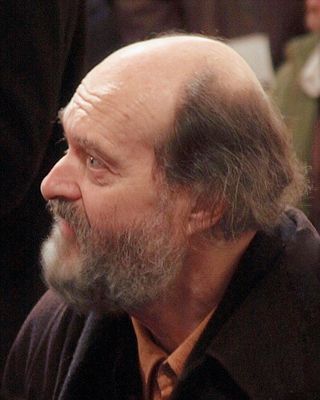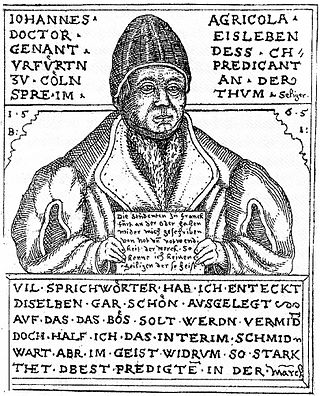
Arvo Pärt is an Estonian composer of contemporary classical music. Since the late 1970s, Pärt has worked in a minimalist style that employs tintinnabuli, a compositional technique he invented. Pärt's music is in part inspired by Gregorian chant. His most performed works include Fratres (1977), Spiegel im Spiegel (1978), and Für Alina (1976). From 2011 to 2018, and again in 2022, Pärt was the most performed living composer in the world, and the second most performed in 2019, after John Williams. The Arvo Pärt Centre, in Laulasmaa, was opened to the public in 2018.
John Harris Harbison is an American composer, known for his symphonies, operas, and large choral works.

The St Matthew Passion, BWV 244, is a Passion, a sacred oratorio written by Johann Sebastian Bach in 1727 for solo voices, double choir and double orchestra, with libretto by Picander. It sets the 26th and 27th chapters of the Gospel of Matthew to music, with interspersed chorales and arias. It is widely regarded as one of the masterpieces of Baroque sacred music. The original Latin title Passio Domini nostri J.C. secundum Evangelistam Matthæum translates to "The Passion of our Lord Jesus Christ according to the Evangelist Matthew".
Alan Ridout was a British composer and teacher.

Geoffrey Alan Burgon was an English composer best known for his television and film scores. Among his most recognisable works are Monty Python's Life of Brian for film, and Tinker Tailor Soldier Spy and Brideshead Revisited for television, the latter two earning Ivor Novello Awards in 1979 and 1981 respectively. He also won BAFTAs for his themes for the remake of The Forsyte Saga and Longitude.

Kanon Pokajanen is a 1997 composition by Arvo Pärt for four-part (SATB) choir. The text is the "Canon of Repentance to Our Lord Jesus Christ", an Orthodox hymn. The text is sung in Church Slavonic and following the tradition of Russian sacred choral music, it is sung a cappella.

The Passio secundum Joannem or St John Passion, BWV 245, is a Passion or oratorio by Johann Sebastian Bach, the earliest of the surviving Passions by Bach. It was written during his first year as director of church music in Leipzig and was first performed on 7 April 1724, at Good Friday Vespers at the St. Nicholas Church.

Berliner Messe is a mass setting by Estonian composer Arvo Pärt. Commissioned for the 90th Katholikentag in Berlin in 1990, it was originally scored for SATB soloists and organ. It was first performed at St. Hedwig's Cathedral on 24 May 1990, the Feast of the Ascension, with Paul Hillier conducting the Theatre of Voices. Pärt later (1997) revised the piece for chorus and string orchestra. Pärt uses his tintinnabuli technique throughout, with movements taking many forms within that style—flowing from quietly reverent duets between parts to full chorus proclamations of faith.

Te Deum is a setting of the Latin Te Deum text, also known as the Ambrosian Hymn attributed to Saints Ambrose, Augustine, and Hilary, by Estonian-born composer Arvo Pärt, commissioned by the Westdeutscher Rundfunk in Cologne, Germany, in 1984. Dedicated to the late Alfred Schlee of Universal Edition, the WDR Broadcast Choir premiered the Te Deum under the direction of conductor Dennis Russell Davies on January 19, 1985. The Te Deum plays an important role in the services of many Christian denominations, including the Paraklesis (Moleben) of Thanksgiving in the Eastern Orthodox Church. Because of the unusual instrumentation Pärt employs, his Te Deum is not suited for use within the Orthodox Church. It was recorded on the ECM New Series label in 1993 by the Estonian Philharmonic Chamber Choir and Tallinn Chamber Orchestra under the direction of Tõnu Kaljuste. The piece is approximately thirty minutes long.

The Brockes Passion, or Der für die Sünde der Welt gemarterte und sterbende Jesus, is a German oratorio, libretto by Barthold Heinrich Brockes, first published in 1712 and seeing 30 or so more editions over the following 15 years.
Arvo Pärt set the Latin text of the Magnificat canticle in 1989. It is a composition for five-part choir (SSATB) a cappella, with several divided parts. Its performance time is approximately seven minutes. The composition is in tintinnabuli style, a style which Pärt had invented in the mid-1970s.

Johann Sebastian Bach composed the church cantata Ich ruf zu dir, Herr Jesu Christ, BWV 177. He wrote the chorale cantata in Leipzig for the fourth Sunday after Trinity and first performed it on 6 July 1732. The cantata text is formed by the unchanged five stanzas of Johann Agricola's hymn.

Jesus Christus ist um unsrer Missetat willen verwundet is a St Mark Passion which originated in the early 18th century and is most often attributed to Reinhard Keiser. It may also have been composed by his father Gottfried or by Friedrich Nicolaus Bruhns. Johann Sebastian Bach produced three performance versions of the Passion, the last of which is a pasticcio with arias from George Frideric Handel's Brockes Passion. There are two other extant 18th-century versions of the Passion, both of them independent of Bach's versions. The Passion was performed in at least three cities in the first half of the 18th century: in Hamburg in 1707 and 1711, in Weimar around 1712, and in Leipzig in 1726 and around 1747.

Johann Sebastian Bach's St Matthew Passion, BWV 244, is structured on multiple levels: the composition is structured in three levels of text sources and by the different forms that are used for musical expression.

Salve Regina is a Marian anthem, a setting by Arvo Pärt of the Latin hymn "Salve Regina" for mixed choir and organ in 2001. It was first performed in Essen Cathedral on 22 May 2002. It was published by Universal Edition in 2002. Pärt arranged the composition for choir, celesta and string orchestra in 2011 for a celebration of 150 years of Italian unity.

De profundis is a choral composition by Arvo Pärt. He wrote the work in 1980, a setting of Psalm 130 in Latin for a four-part men's choir, percussion and organ. It was first performed at the Martinskirche, Kassel on 25 April 1981, conducted by Klaus Martin Ziegler. Pärt dedicated the work of around 7 minutes to Gottfried von Einem. It was published by Universal Edition. Pärt arranged it for chamber orchestra in 2008.
St Mark Passion is a Passion, written in baroque style by Nikolaus Matthes (*1981) between April 2019 and April 2020. It describes the passion, death and sepulture of Jesus. It contains the entire text of chapters 14 and 15 of the Gospel of Mark.












